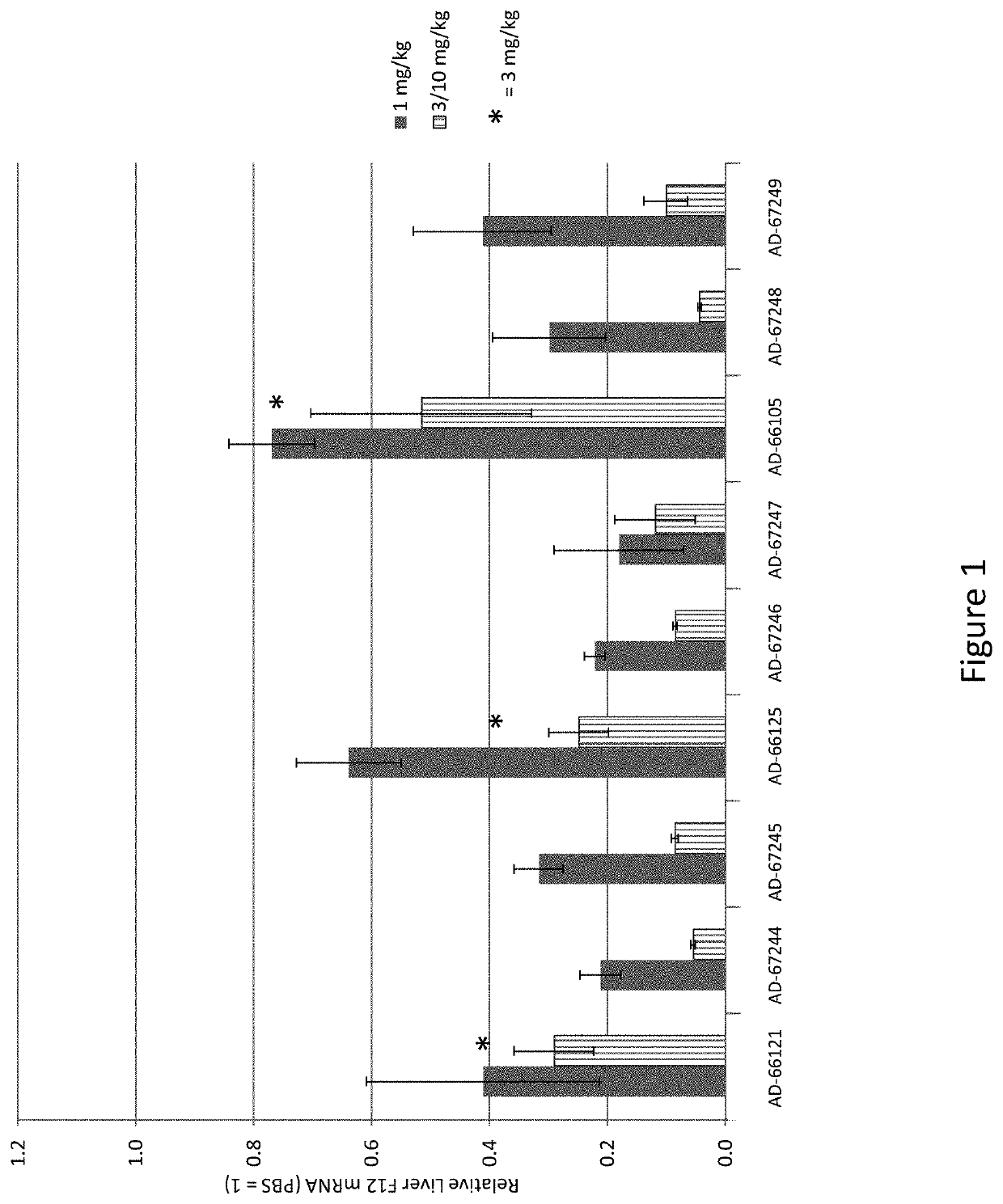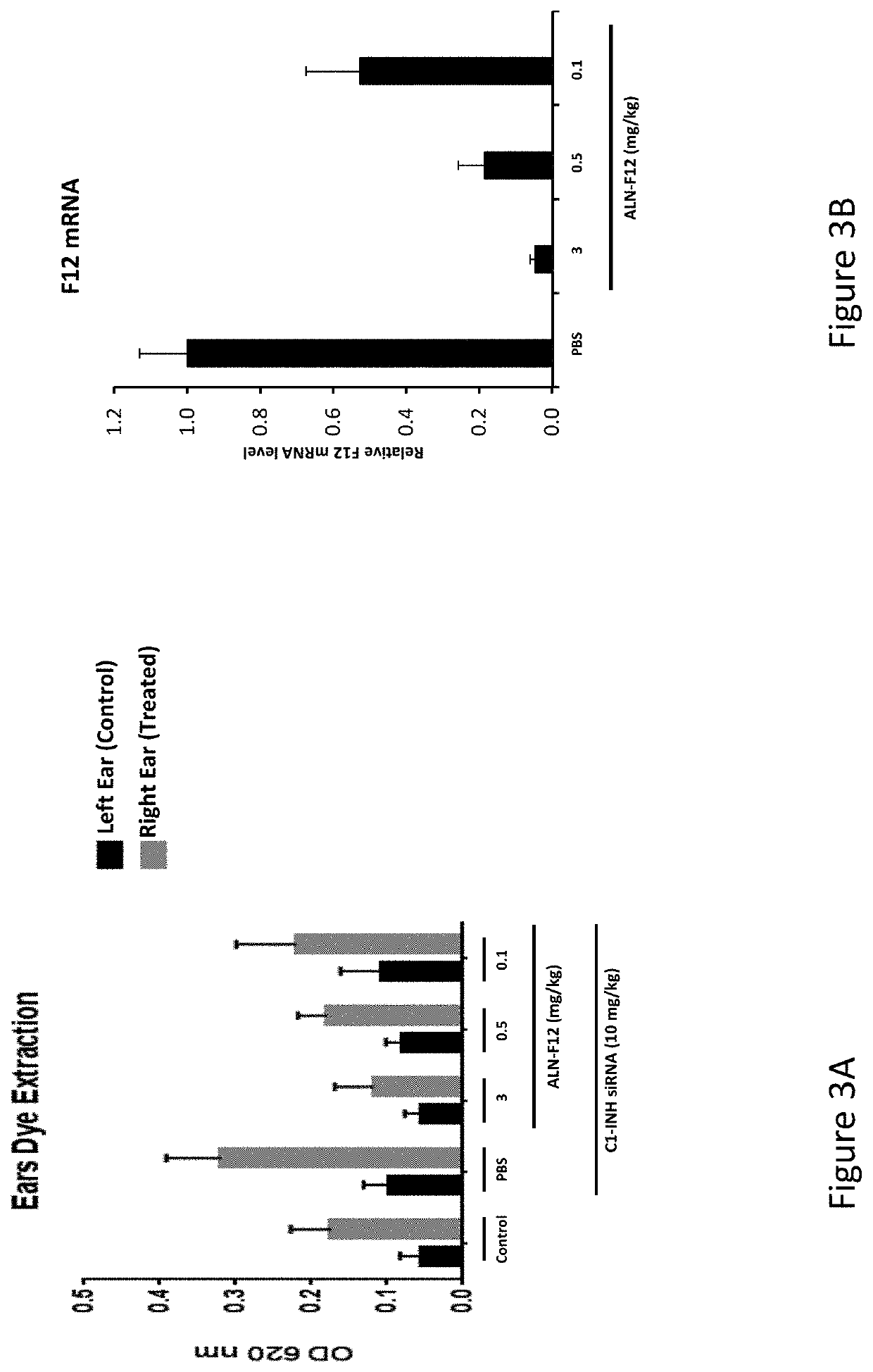METHODS FOR TREATING OR PREVENTING CONTACT-ACTIVATION PATHWAY-ASSOCIATED DISEASES USING iRNA COMPOSITIONS TARGETING FACTOR XII (HAGEMAN FACTOR) (F12)
a technology of irna compositions and irna compositions, applied in the direction of drug compositions, cardiovascular disorders, biochemistry apparatus and processes, etc., can solve the problems of frequent hospitalization, inability to perform surgery, and severe pain
- Summary
- Abstract
- Description
- Claims
- Application Information
AI Technical Summary
Benefits of technology
Problems solved by technology
Method used
Image
Examples
example 1
Synthesis
Source of Reagents
[0636]Where the source of a reagent is not specifically given herein, such reagent can be obtained from any supplier of reagents for molecular biology at a quality / purity standard for application in molecular biology.
Transcripts
[0637]siRNA Design
[0638]A set of siRNAs targeting the human F12. “coagulation factor XII” (human: NCBI refseqID NM_000505; NCBI GeneID: 2161), as well as toxicology-species F12 orthologs (cynomolgus monkey: XM_005558647; mouse; NM_021489; rat, NM_001014006) were designed using custom R and Python scripts. The human F12 REFSEQ mRNA has a length of 2060 bases. The rationale and method for the set of siRNA designs is as follows: the predicted efficacy for every potential 19mer siRNA from position 50 through position 2060 (the coding region and 3′ UTR) of human F12 mRNA (containing the the coding region and 3′ UTR) was determined using a linear model that predicted the direct measure of mRNA knockdown based on the data of more than 20.0...
example 2
Screening of F12 siRNA Duplexes
Cell Culture and Transfections
[0643]Hep3b or Primary Mouse Hepatocyte cells (PMH) (MSCP10. Lot #MC613) were transfected by adding 4.9 μl of Opti-MEM plus 0.1 μl of Lipofectamine RNAiMax per well (Invitrogen, Carlsbad Calif. cat #13778-150) to 5 μl of siRNA duplexes per well into a 384-well plate and incubated at room temperature for 15 minutes. Forty μl of DMEM (Hep3b) of William's E Medium (PMH) containing about 5×103 cells was then added to the siRNA mixture. Cells were incubated for 24 hours prior to RNA purification.
[0644]Single dose experiments were performed at 10 nM and 0.01 nM final duplex concentration and dose response experiments were done over a range of doses from 10 nM to 36 fM final duplex concentration over 8, 6-fold dilutions.
Total RNA Isolation Using DYNABEADS mRNA Isolation Kit:
[0645]RNA was isolated using an automated protocol on a BioTek-EL406 platform using DYNABEADs (Invitrogen, cat #61012). Briefly, 50 μl of Lysis / Binding Buffer...
example 3
12 Silencing in Wild-Type Mice
[0653]Three of the most active agents targeting F12, described above, were selected for further evaluation. In particular, additional agents targeting nucleotides 2017-2040, or nucleotides 315-338, or nucleotides 438-459 of NM_000505 (an F12 gene) were synthesized as described above. The in vivo efficacy of these additional agents was assessed by administration of a single subcutaneous dose of the agent to wild-type C57BL / 6 mice and determining the level of mRNA at 7-10 days post-dose. The unmodified nucleotide sequences of the sense and antisense strands of the agents targeting F12 are provided in Table 9, and the modified nucleotide sequences of the sense and antisense strands of the agents are provided in Table 10.
[0654]In particular, wild-type C57BL / 6 mice were administered either a single 1 mg / kg dose or a single 3 mg / kg dose, or a single 1 mg / kg dose or a single 10 mg / kg dose of the agent and the level of F12 mRNA was determined at 7-10 days post-...
PUM
| Property | Measurement | Unit |
|---|---|---|
| pH | aaaaa | aaaaa |
| pH | aaaaa | aaaaa |
| length | aaaaa | aaaaa |
Abstract
Description
Claims
Application Information
 Login to View More
Login to View More - R&D
- Intellectual Property
- Life Sciences
- Materials
- Tech Scout
- Unparalleled Data Quality
- Higher Quality Content
- 60% Fewer Hallucinations
Browse by: Latest US Patents, China's latest patents, Technical Efficacy Thesaurus, Application Domain, Technology Topic, Popular Technical Reports.
© 2025 PatSnap. All rights reserved.Legal|Privacy policy|Modern Slavery Act Transparency Statement|Sitemap|About US| Contact US: help@patsnap.com



